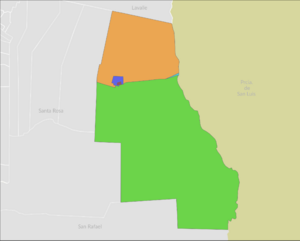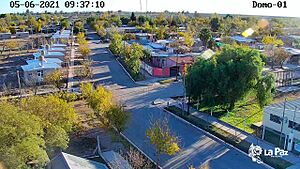La Paz, Mendoza facts for kids
Quick facts for kids
La Paz
|
|
|---|---|
| San José de Corocorto | |
| Country | |
| Province | Mendoza |
| Department | La Paz |
| Population
(2022)
|
|
| • Total | 11.931 |
| Demonym(s) | Paceño/a |
| Time zone | UTC−3 (ART) |
| CPA base |
M5590
|
| Dialing code | +54 2626 +54 2635 |
| Climate | BWk |
La Paz is a department in the province of Mendoza, Argentina. Its main town has the same name. La Paz is about 145 kilometers (90 miles) from the capital city of Mendoza.
This area is very important for trade in Mercosur, which is a group of South American countries. Two major roads, National Route 7 and National Route 146, cross through La Paz. These roads connect the region to the rest of Argentina. They are also key for connecting countries in the Southern Common Market. La Paz is the main entry point into Mendoza Province from the east.
Contents
Exploring La Paz's Geography
The La Paz department is divided into several areas. These include:
- La Paz North
- La Paz South
- Desaguadero
- Villa Antigua
- Villa Nueva de La Paz
How Many People Live in La Paz?
In 2010, about 9,867 people lived in the department of La Paz. This made it the least populated department in Mendoza Province at that time.
Earthquakes in the Region
The Cuyo area, where La Paz is located, often experiences strong earthquakes. Big earthquakes have happened about every 20 years.
One very strong earthquake happened on March 20, 1861. It caused about 12,000 deaths. This event was a major turning point for Argentina. Since then, governments have made strict rules for building homes and other structures.
Another strong earthquake hit in 1920 with an intensity of 6.8. It damaged many buildings and caused cracks in the ground. About 250 people died because adobe houses collapsed.
In 1929, an earthquake in southern Mendoza killed 30 people. This was also due to houses falling down. A more recent serious earthquake happened in 1985. It lasted for 9 seconds and caused an old hospital to collapse.
La Paz is on a flat plain, far from mountains. This means it is usually further from where earthquakes start. So, the chance of a strong earthquake directly hitting La Paz is lower than in other parts of Mendoza Province.
Beliefs and Religions
La Paz has a high number of people who follow the Catholic faith. About 86.5% of the population identifies as Catholic.
|
A Look at La Paz's History
The first people to live in the La Paz area were the Huarpes. They called their land Yopacto. Their leader was a chieftain named Corocorto.
Spanish explorers arrived in these lands with Captain Sancho de Medrano. To teach the local people about Christianity, a small chapel was built. It was made of branches and mud and dedicated to San José. In the 1760s, a small temple replaced it. Today, this temple holds an image of Our Lady of La Paz. Every January 24, a religious festival is held there. It includes a special prayer period and a procession around the Plaza de la Villa Antigua.
In the early 1700s, many carts traveled from Mendoza to the coast. They carried local products. The journey was very long. Important stops along the way were Postas del Desaguadero and San José de Corocorto. Because of this, Commander Amigorena founded a town on December 24, 1791. He named it San José de Corocorto, which is now Villa Antigua.
On August 4, 1850, Governor Alejo Mallea changed the town's name to La Paz. He also gave it a large territory of over 14,000 square kilometers (5,400 sq mi). This area included parts of what is now the Lavalle department. Governor Mallea moved the government offices to a new town called Villa Nueva. Both Villa Nueva and the new municipality were named La Paz.
The province's constitution, created on November 18, 1855, divided Mendoza into four departments. These were San Vicente (now Godoy Cruz), San Carlos, San Martín, and La Paz.
On October 12, 1936, the Desaguadero Arch was opened. This was part of a plan to encourage tourism. Since then, it has been the main entrance to Mendoza Province from San Luis. It is located on National Route 7.
Famous People from La Paz
Over time, several important cultural figures were born in La Paz. They left a lasting mark and became known beyond the department's borders. Some of these famous people include:
- Felix Dardo Palorma: Known as the "Compadre de Cuyo," he was an Argentine singer, musician, and composer. He wrote many famous folk songs from the Cuyo region.
- Gabino Coria Peñaloza: He was an Argentine poet and writer. He is famous for writing the lyrics to popular tangos like "Caminito." He also wrote for great tango singers like Carlos Gardel.
- Enrique Dussel: He was a well-known academic, philosopher, and historian. He is famous for his work in ethics and political philosophy. He helped start the Liberation Philosophy movement.
Keeping La Paz Safe
La Paz is working to improve safety for its residents. The department is creating a special center to watch over public and important places. This center will use a system of surveillance cameras. These cameras can zoom in and are placed at key spots around the department.
Images for kids
See also
 In Spanish: La Paz (Mendoza) para niños
In Spanish: La Paz (Mendoza) para niños





